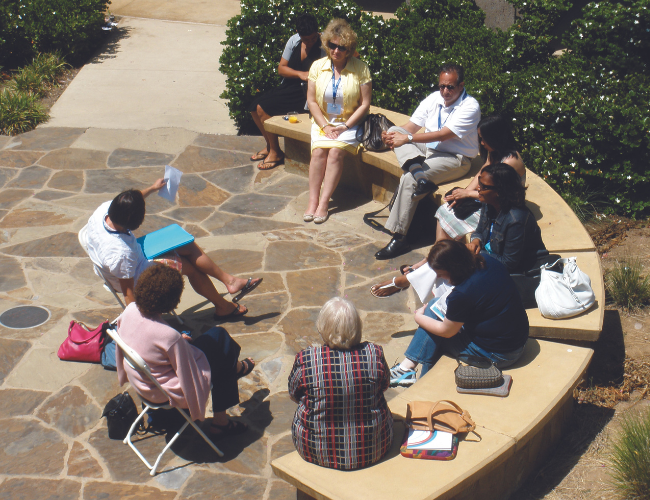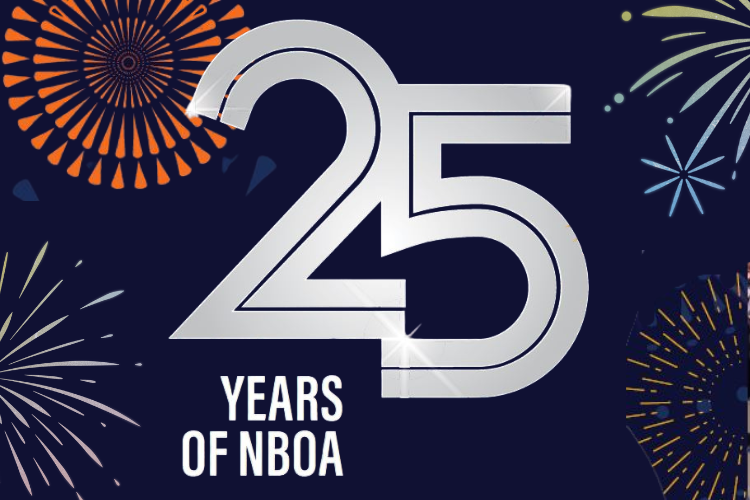In the beginning there was an idea. Then a list serv. And soon thereafter a newsletter, a website and a conference. But more important than any of those resources, there were independent school business officers who were ready and willing to share their expertise to a degree not seen in many other professional associations.
NBOA members are special. Business officers are truly among the most generous and talented professionals around. It can be seen on NBOA Connect, where members pass along experiences and policies. It can be seen at NBOA Annual Meetings, where you share lessons learned and successes earned. It can be seen in the stories produced for Net Assets magazine that feature our members’ hard work. It can be seen in every aspect of the association — it can be seen most vividly in our national community of independent school business, finance and operations, professionals.
This is the story of how NBOA came to be, how it’s evolved over 25 years, and where it is going in the next 25 years. While Net Assets magazine is known for delivering practical insights and strategies about independent school business and operational matters, this issue is dedicated to the celebration of the very special NBOA community.
Let’s take a moment to appreciate the roles NBOA members are in around the U.S. and the world. Together, the Board of Directors, volunteers, all of our members, and NBOA staff have made independent schools and the entire community stronger through times of hardship and plenty, through traditions and innovations. Together, we are NBOA.
Origin Story
Some have said the idea for the National Business Officers Association was born on a cocktail napkin. Research would suggest it was more like several cocktail napkins. There were meetings at bars and restaurants following piecemeal professional development opportunities for business officers. There was a meeting on the beach in Hawaii, when the first NBOA Board Chair (then known as President) Terry Armstrong met with founding business officer Will Hancock to outline their vision for a national group. There was a meeting at Commonfund with founding business officer Dick Elkins, and then Commonfund president Bob Bovinette, when Commonfund donated key funds to launch the fledgling startup that NBOA once was. Then Sarah Daignault, NBOA’s founding executive director, did the 501(3)(c) paperwork to get the group incorporated.


Boiling the birth of NBOA down to any singular moment may be too simple, but one thing is clear: it was the work of business officers for business officers, with courageous support from their school leadership.
Before NBOA, independent school business officers were served by regional groups, if you were lucky enough to live in an area where a regional group existed. NAIS offered some services until the mid-1990s, when a new strategic plan clarified they would serve primarily heads, boards and those supporting the academic program. And vendors offered some programs. But the need for more robust support was clear to those in the job, particularly in the 1990s, as the role became more complicated, between compliance, changes in health insurance and increased institutional risk, which Daignault outlines in her Reflections column (see page 5).
“There weren’t the kind of support systems that there are now at all,” said founding business officer Dee Forgette. “In fact, most schools of small and medium size may have had only a bookkeeper. They didn’t have what we know as a business officer today. And human resources officers were almost unheard of. There was just an explosion of compliance issues,” she continued. “Having a national group was really important because, we used to joke, whatever starts in California ends up in Washington. Everything spreads.”
The nature of the role also provided a clear need – and is one reason NBOA continues to be the strong network that it is today. “We are in a working environment where basically nobody knows what we do,” said Hancock. “The business office can feel really isolated. Having a forum where someone really understands your job is invaluable.” And the work isn’t something you can learn about in school: “How do you train for the array of things that are going to cross your desk? You just can’t prepare yourself for it,” commented long-time business officer Cindy Stadulis.
Thankfully, business officers have long been willing to help each other out. “From the very beginning, business officers were not competitive with each other,” noted Forgette. “They have no vested interest other than making the school run as best they can. And I think that’s part of the joy of the whole thing.”
A group of 30 leading business officers, called ABOIS — The Association of Business Officers of Independent Schools — had established a network for sharing best practices, which they aimed to bring back to schools in their region one by one. They could see, however, that sharing the practices more widely and systematically would help more schools and therefore the sector as a whole.
“ABOIS was a good example of what you could do for your colleagues if you worked together, but it only met once a year,” said Armstrong. It was also a volunteer operation with limited capacity. It was hard to get out of the weeds and think more strategically, Armstrong explained. “Originally there was hope that we could build on what Ken White was doing in Atlanta and take one or more of the regional groups national,” he explained. “But the regional groups had their own unique functions, so that wasn’t going to work. We realized we needed to start something from whole cloth."
But What Are We Actually Going To Do?
Armstrong and Hancock convinced 21 other business officers to form NBOA, who in turn had to convince their heads of school to commit dues of $3,000 to the organization for three years, regardless of school size. And they had to make this commitment before the association offered a single resource. It was not a small ask, especially for the smaller schools.
“It didn’t matter what your budget was,” said founding business officer Bobbi Whiting, who was at one of the smallest founding schools. “You all pitched in, and you just made a go of it. It was rolling up your sleeves, like starting any organization. It didn’t matter whether you were on the board or whether you were getting paid.”
The task was simple. “It was to be an organization to serve the needs of all business officers,” explained Hancock. The opportunities were immense. “But what were we actually going to do?” Daignault recalls wondering after the papers were signed and the Board sat down to its first meeting at the 1998 NAIS conference.
Some of the planning work fell to the Board — initially the founding members — and much of it to Daignault, who was the board chair of The Madeira School at the time but otherwise between CFO jobs. She did initial legwork as a volunteer, and then the Board voted her to serve as the executive director. Daignault worked out of Maryland initially before moving to Boulder, Colorado, then Holt Whiting and Hancock joined as part-time staff, working out of North Carolina and Hawaii respectively.
Net Assets newsletter was established in NBOA’s first year. “It looked like a church bulletin,” said Daignault. “It was four pages, with clip art graphics, and I would put labels on each copy by hand.” Anyone who stopped by her home office would be enlisted in labeling the newsletter — family, friends and fellow business officers.
.png?sfvrsn=6ec23f6e_1)
The Board set a goal to reach 50 member schools by the second board meeting, which was scheduled for February 1999. In fact, the 50th school, Brewster Academy, called Daignault to join as she was on her way to the gathering in Dallas. The early success was followed by many others, some entirely unanticipated.
That year, NBOA bought booth space at the NAIS exhibit hall to recruit new members. “Business officers do not spend easily, but we decided to spend some money,” Daignault explained. “We had to rent chairs, carpet, make a sign, figure it out.” The investment was well worth it. “It did not dawn on us that if you put a booth with a business officer association in the middle of the exhibit hall, every vendor there will be asking, ‘Can we join?’” reported Daignault. So staff and Board worked quickly to set up a new membership category and pricing for business partners.
Recruiting member schools continued to be successful as well. Forgette led a group called “the booth babes,” which all involved recognize would not be the terminology used today. The term was not gender specific; both men and women worked the exhibit table and played a critical role in recruiting. “As a grassroots organization, we were asked to do so much in regard to recruiting members and trying to demonstrate to them the importance of this program, and the opportunity to join and what that meant,” reported Stadulis. “We were trying to reel in our friends. We said, ‘You have got to get on board because there’s amazing momentum in what’s going to happen at NBOA.’”

After that first year of exhibiting at NAIS, NBOA had sufficient resources to hold its first large gathering. Working on a still tenuous budget, the NBOA staff trundled their projector, handouts and other conference materials several blocks down a New York City street in suitcases, to save on hotel fees. Then dubbed the Symposium, the first iteration of the NBOA Annual Meeting was a rousing success by all accounts. While 125 business officers may seem like a small number today, never before had that many gathered in one space.
With each year, more resources. A website. Research. A seminar for senior leaders. The first such seminar sponsored by TIAA felt like such an accomplishment, both Hancock and Daignault remember “doing a jig in the street” when they secured the support, realizing how much the little association could accomplish. And with more financial resources, NBOA was able to hire more staff to handle marketing and membership processes, build a better website, expand the newsletter into a magazine, and run a larger conference.
It was also easier to convince people to join; after three years, dues switched to a sliding scale based on budget size, and when colleagues saw what was offered, they wanted in. “Pretty much like a rocket out of a cannon, people heard about NBOA and they wanted to join,” said former NBOA Board Chair Kate Lindsey.
While a tremendous amount of work on the part of staff and the Board, it was also steady going. “We’re a bunch of doers,” said Stadulis. “That’s what motivated NBOA in the beginning. The attitude was, Let’s make it happen.” And they did. “It seemed very natural to continue doing what we’d been doing and what we believed was beneficial to our schools,” said Armstrong. “Yes, we stressed about it, but never in any serious way. There was never any real serious threat to NBOA being successful. It was just a matter of, you know, not screwing it up.”

Professional Friendship
In the early days when it was a small group, the connections were deep. “It was that camaraderie that you get stuffing envelopes altogether, or going to a board meeting in a restaurant because we didn’t have a boardroom,” recounted Bobbi Whiting. And there was always off-hours socialization. “After conferences we’d go out together. We’d go to blues bars in Chicago to listen to music and the Vanguard in New York to listen to some jazz and various restaurants,” said Armstrong. “There was familiarity, respect. We liked these people. They weren’t just CFOs. These were people we knew and we cared about as friends.” Stadulis recalled a dance party at a Summer Institute, the precursor to the Business Officer Institute: “Judge Ito [nationally known from the OJ Simpson trial] called to complain that we were being too noisy,” she said. “It was a fun group.”
“It’s really that relationship that made us all stronger and better,” Stadulis continued. “We knew that we could rely on each other if we got into a pinch or were in a difficult situation. We were able to brainstorm with others, and there was a confidentiality and a trust and respect when you had to reveal something you didn’t know how to manage.
“And we were there for each other not only professionally, but personally. You had births, you had marriages, you had divorces, you had deaths, you had surgeries, you had health issues, you had all kinds of things and you got to know people at a deeper level.” It is true “professional friendship” in her words.



.png?sfvrsn=a0b06f90_1)

.png?sfvrsn=e0147111_1)

